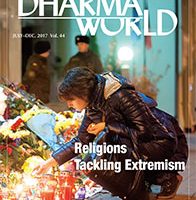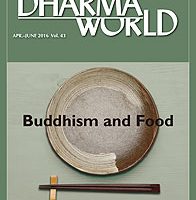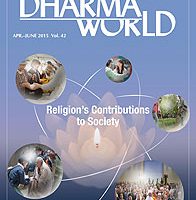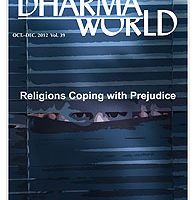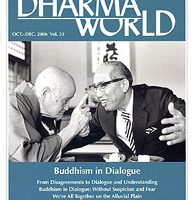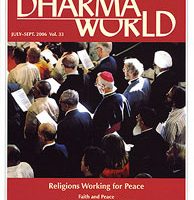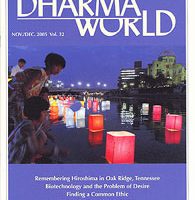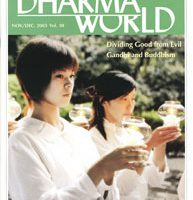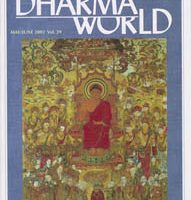January-February 2002, Volume 29(PDF)
Religious Delegates Gather in New York for WCRP Symposium
Reflections
Lessons Learned from What May Seem Dirty by Nikkyo Niwano
This essay is part of an ongoing series of translations from a recent volume of inspirational writings by the late founder of Rissho Kosei-kai. Dharma World will continue to publish these essays because of their permanent value as guidance for the practice of one’s faith in daily life.
Nikkyo Niwano, the late founder of the Buddhist association Rissho Kosei-kai, was an honorary president of the World Conference on Religion and Peace (WCRP) and was honorary chairman of Shinshuren (Federation of New Religious Organizations of Japan) at the time of his death in October 1999.
We Can Change Ourselves by Nichiko Niwano
Human beings are capable of both good and evil. No one can claim that he or she alone is absolutely right. By the same token, everyone has an essential role in life.
Nichiko Niwano is president of Rissho Kosei-kai and the Niwano Peace Foundation, a president of the World Conference on Religion and Peace (WCRP), and vice-chairman of Shinshuren (Federation of New Religious Organizations of Japan).
Essays
A Global Ethic in an Age of Global Terror by Gunther Gebhardt
A German Christian theologian points out the dangers of blaming an entire religion for the criminal acts of a small minority of fanatics. In doing so, he also describes the progress of the multinational, multireligious Global Ethic Project.
Gunther Gebhardt is a German-born Christian theologian. He received his doctorate from Fribourg University in Switzerland with a thesis on peace education in religious peace movements. From 1984 to 1997, he was European secretary-general of the WCRP at Geneva; and from 1997 to 1998, executive secretary of the Swiss Institute for Development at Biel. Since 1998 he has been academic program coordinator of the Global Ethic Foundation at Tubingen, Germany.
The Equality of All That Lives by Jion Abe
A recently deceased Japanese Zen priest and scholar of Indian philosophy here explores the roots of the Buddhist concept of peace, which respects all forms of life and advocates their shared existence.
Jion Abe, who died on January 24, 2001, obtained his Ph.D. from the University of Pune and studied also at the Bhandarkar Oriental Research Institute, both in India. He completed doctoral studies at the University of Tokyo, where he specialized in Indian philosophy. He was a professor in the Department of Literature at Meiji University in Tokyo and priest-in-charge of the Soto Zen temple Mokusen-ji in Kamakura.
Jack Kerouac’s “Dharma Bums”-and America as a Pure Land by Miriam Levering
A revival of interest in the work of the American writers who constituted the “Beat Generation” of the ’50s and ’60s is focusing renewed attention on the serious Buddhist elements in Jack Kerouac’s writings.
Miriam Levering was educated in history and the comparative history of religion at Wellesley College and Harvard University, where she received her Ph.D. in 1978. She teaches Buddhism, Chinese and Japanese Religion at the University of Tennessee in Knoxville, Tennessee. She has edited a book called Rethinking Scripture (1989), a study of the concept and use of sacred texts in the major religious traditions, and has written many articles on women and gender in Ch’an and Zen Buddhism.
Buddhist Living
A Reawakened Awareness of Family Love
A wife and mother who was having difficulties with her second daughter was also confronted by her husband’s increased drinking-only to then be told that she herself had developed final-stage cancer.
Kiyoko Mikuriya is a member of the Yokkaichi Branch of Rissho Kosei-kai in Mie Prefecture.
Buddhist Sculpture
A Gentle, Elegant Jizo Bosatsu by Takeshi Kuno
This graceful statue from the Kamakura period (1185-1333) of one of Japan’s most beloved bodhisattvas was carved by the noted sculptor Kaikei (fl. late twelfth-early thirteenth century). Excellently preserved, it retains its original beauty.
Takeshi Kuno, formerly a director of the Tokyo National Research Institute for Cultural Property, is now director-general of the Institute of Buddhist Art Research in Tokyo.
Gotama Buddha (52)
The Rise and Fall of the City of Pataliputra by Hajime Nakamura
Buddhism developed because of Gotama’s focus on lay people. It was the community of the ordained, however, that converted the “Last Journey” into a scripture, blurring the contents of the teaching given to lay people.
The late Hajime Nakamura, an authority on Indian philosophy, was president of the Eastern Institute in Tokyo and a professor emeritus of the University of Tokyo at the time of his death in October 1999. This series is a translation of Gotama Buddha, vol. 2, Tokyo, Shunjusha, 1992.
The Threefold Lotus Sutra: A Modern Commentary (62)
The Sutra of the Lotus Flower of the Wonderful Law
Chapter 4: Faith Discernment (3) by Nikkyo Niwano
This is the sixty-second installment of a detailed commentary on the Threefold Lotus Sutra by the late founder of Rissho Kosei-kai, Rev. Nikkyo Niwano.


















